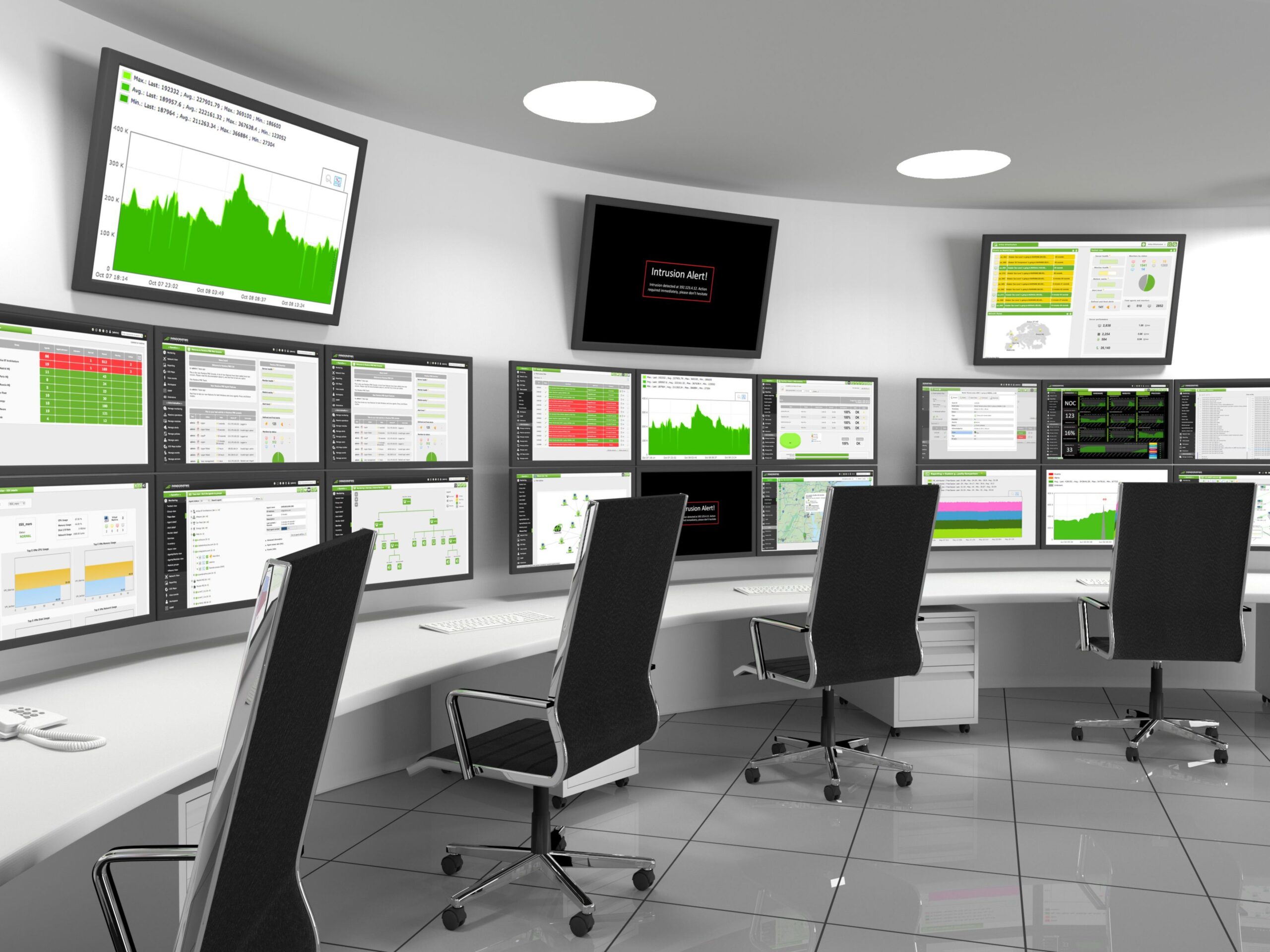Introduction
The importance of network monitoring cannot be overstated for businesses of all sizes. As networks grow in size and complexity, their significance to a company increases. From collaboration to communication and commerce, everything that keeps a business running depends on a functioning network. The purpose of this blog is to provide an overview of best practices for network monitoring, and how it can help businesses avoid costly downtime, loss of data and maintain a strong reputation.
Section 1: Understanding Network Management
Network management is the process of administering and maintaining a computer network infrastructure. It involves a variety of tasks, including designing, installing, configuring, securing, monitoring, and maintaining a network of computers, servers, storage devices, and other networking equipment. A network administrator is responsible for managing these tasks, ensuring that the network is running efficiently and effectively, and responding to any issues that arise.
The role of a network administrator is critical to the success of an organization, as the network is the backbone of most businesses today. The administrator must be able to work with a wide range of network technologies, including hardware, software, and protocols. They must also have excellent problem-solving skills, as they will be responsible for troubleshooting and resolving any network issues that arise.
One of the most important aspects of network management is having accurate and real-time information about the usage, performance, and status of every device, application, and data on the network. This information is essential for identifying and resolving issues before they become critical and cause downtime or other problems.
To obtain this information, network administrators use network monitoring tools that enable them to track the performance of the network in real-time. These tools provide valuable insights into the network’s usage, performance, and status, allowing administrators to proactively address issues before they become serious problems.
Network monitoring tools can track a wide range of metrics, including bandwidth utilization, network latency, packet loss, and error rates. These metrics help administrators identify potential bottlenecks and other issues that could impact network performance. They can also provide detailed reports and alerts when issues arise, allowing administrators to quickly take action to resolve them.
Another important aspect of network management is security. Network administrators must ensure that the network is secure from external threats, such as hackers and viruses, as well as internal threats, such as employee misconduct or data breaches. They must also ensure that all devices and software on the network are up to date with the latest security patches and updates.
In addition to monitoring the network for potential security threats, administrators must also implement access controls to ensure that only authorized personnel have access to sensitive data and applications. This includes implementing password policies, firewalls, and other security measures to protect the network from unauthorized access.
Overall, network management is a critical aspect of any organization’s IT infrastructure. It requires skilled professionals who can manage complex network technologies and ensure that the network is running efficiently and securely. With the right tools and practices, network administrators can proactively manage their networks, identify and resolve issues before they become critical, and ensure that their organizations are able to operate efficiently and effectively.
Section 2: The Domain of Network Monitoring
In today’s digital age, networks are the backbone of modern businesses. They enable employees to communicate with one another and access important data from anywhere in the world. However, managing a network can be a challenging task, especially for organizations that have a large and complex infrastructure.
This is where network monitoring comes in. Network monitoring is the practice of continuously monitoring an organization’s network to identify and address issues before they become critical. It involves using various tools and techniques to collect data about the network’s usage, performance, and status, and then analyzing that data to identify any potential issues.
The domain of network monitoring covers a wide range of activities, including:
- Performance Monitoring: Performance monitoring involves measuring and analyzing the performance of network components such as routers, switches, servers, and applications. By monitoring performance metrics such as latency, throughput, and packet loss, network administrators can identify and resolve bottlenecks, congestion, and other issues that can impact network performance.
- Fault Management: Fault management involves identifying and resolving network faults, such as hardware failures, software errors, and configuration issues. By monitoring the network for faults and taking appropriate actions to resolve them, network administrators can minimize downtime and ensure that the network remains available and reliable.
- Configuration Management: Configuration management involves managing the configurations of network components such as routers, switches, firewalls, and servers. By monitoring the configurations of these devices and ensuring that they are up-to-date and compliant with organizational policies and industry best practices, network administrators can minimize security risks and ensure the network’s stability and reliability.
- Security Management: Security management involves identifying and managing security threats to the network, such as malware, viruses, and unauthorized access attempts. By monitoring the network for security threats and taking appropriate actions to mitigate them, network administrators can minimize the risk of data breaches, network downtime, and other security-related issues.
- Capacity Planning: Capacity planning involves forecasting future network usage and capacity requirements and taking appropriate actions to ensure that the network can meet those requirements. By monitoring network usage patterns and capacity metrics such as bandwidth utilization and storage capacity, network administrators can identify potential capacity issues and take appropriate actions to prevent them.
Overall, the domain of network monitoring is critical for maintaining the availability, reliability, and security of an organization’s network. By continuously monitoring the network and taking appropriate actions to address issues, network administrators can minimize downtime, improve network performance, and ensure that the network remains available and reliable for the organization’s employees and customers.
Section 3: Top Ten Reasons to Use Network Monitoring
Network monitoring is a critical function in maintaining the availability of an organization’s network. It involves continuously monitoring the network to identify and address issues before they become emergencies. There are numerous reasons why businesses should invest in network monitoring solutions, and this section will highlight the top ten reasons to use network monitoring.
- Know what is happening: Network monitoring solutions provide real-time information about the operation and connectivity of devices and resources on the network. Without this feature, you may have to wait until someone tells you that something is down before you can fix it.
- Plan for upgrades or changes: Network monitoring applications allow you to track usage data and identify when a device is constantly down or the bandwidth to a subnet is consistently running near its limit. This information enables you to plan for upgrades or changes that will prevent further issues.
- Diagnose problems: Network monitoring allows you to identify the root cause of problems, saving time and reducing frustration. For example, if a server is unreachable from the intranet, you can quickly determine whether the issue is with the server, switch, or router.
- Show others what is going on: Graphical reports provide a clear picture of the health and activity on the network. These reports can be used to prove an SLA or demonstrate the need to replace a problematic device.
- Know when to apply your disaster-recovery solutions: With enough warning, you can transfer the operation of important servers to a backup system until the primary system can be repaired and brought back online. Without network monitoring, you may not know there is a problem until it is too late.
- Ensure your security systems are operating: Network monitoring enables you to confirm that your security software and hardware are functioning as expected, protecting your network from cyber threats.
- Keep track of your customer-facing resources: Many devices on your network are critical applications running on a server, such as HTTP, FTP, and mail. Network monitoring can watch these applications and ensure that customers can connect to the servers and access the information they need.
- Be informed of your network status from anywhere: Many network monitoring applications provide remote viewing and management from anywhere with an internet connection. This feature enables you to monitor your network and resolve issues even when you are away from the office.
- Ensure customer satisfaction: If you have customers depending on your network for their business, you need to be sure that they are up and running at all times. Network monitoring enables you to detect and resolve issues before they impact your customers, improving their satisfaction with your services.
- Save money: Above all, network monitoring helps you cut down on the total amount of downtime and time it takes to investigate problems. This translates to fewer man-hours and less money when problems arise, enabling you to invest more in your business’s growth.
In conclusion, network monitoring is critical to the successful operation of any modern organization. By providing real-time information about the network’s performance and availability, network monitoring enables organizations to prevent downtime, diagnose problems, plan for upgrades, ensure customer satisfaction, and save money.
Section 4: What to Monitor and Why
In today’s digital age, networks are an essential component of modern organizations. They connect employees, devices, and applications, enabling the flow of data and information necessary for efficient and effective business operations. As networks grow in size and complexity, it becomes increasingly important to monitor them continuously to ensure availability, reliability, and security. In this section, we will explore the key types of network status information that need to be monitored and explain why each type of information is critical to maintaining network availability and reliability.
- Network device availability: Network devices such as switches, routers, and firewalls are critical components of any network. Monitoring their availability is essential to ensure that they are functioning correctly and that data can flow across the network unimpeded. A device failure can have a cascading effect, causing disruptions throughout the network. Monitoring device availability can help identify issues before they become critical, enabling proactive troubleshooting and minimizing downtime.
- Server disk space: Servers are the backbone of any network, hosting applications, data, and files. As data accumulates on servers, disk space can quickly fill up, leading to performance degradation and even server failure. Monitoring server disk space allows administrators to identify and address potential issues before they affect server performance or cause a server to crash.
- Firewall functionality: Firewalls are a critical component of network security, protecting against unauthorized access and data breaches. Monitoring firewall functionality ensures that it is operating correctly and that it is protecting the network as intended. A malfunctioning firewall can leave the network vulnerable to attack, compromise data security, and disrupt network performance.
- Antivirus protection: Antivirus software is an essential tool for protecting networks from malware and other security threats. Monitoring antivirus protection ensures that the software is up-to-date, and it is working correctly. Malware can infect systems and cause significant disruptions, leading to downtime and potential data loss. Monitoring antivirus protection is critical to ensure the network is protected against malware threats.
- Update servers: Updating software and operating systems is an essential part of maintaining network security and performance. Monitoring update servers ensures that software updates are being delivered and installed correctly, and that they are not causing issues with network devices or applications. An update failure can lead to network vulnerabilities, application errors, and other problems.
- Spyware/malware defenses: Spyware and malware are significant threats to network security, compromising data and putting networks at risk. Monitoring spyware and malware defenses ensures that they are functioning correctly and that they are providing the necessary protection against these threats. A failure in spyware/malware defenses can leave the network vulnerable to attack and put critical data at risk.
- Bandwidth utilization: Bandwidth is a finite resource, and as applications and devices consume more bandwidth, network performance can suffer. Monitoring bandwidth utilization allows administrators to identify bandwidth hogs and take steps to optimize network performance. An unoptimized network can lead to slow application performance, decreased employee productivity, and ultimately, business inefficiencies.
- Application availability: Applications are the lifeblood of any organization, and downtime can be costly in terms of lost revenue, decreased employee productivity, and customer dissatisfaction. Monitoring application availability ensures that applications are up and running, delivering the functionality needed for day-to-day business operations.
- Network traffic: Network traffic can reveal potential issues with network performance and security. Monitoring network traffic enables administrators to identify unusual traffic patterns, potential security breaches, and other issues that can impact network performance.
- Network performance: Finally, monitoring network performance provides a holistic view of the network, enabling administrators to identify and address issues before they become critical. Network performance monitoring can provide insight into the speed and responsiveness of the network, enabling administrators to optimize network performance and improve employee productivity.
In conclusion, monitoring network status information is critical to maintaining network availability, reliability, and security. By continuously monitoring the network, network administrators can quickly identify and address issues before they become emergencies, saving time, money, and resources. They can also plan for upgrades and changes, ensuring the network is always operating at optimal levels.
The top ten reasons to use network monitoring are clear, and they all center around the ability to keep the network running smoothly and efficiently. From diagnosing problems and tracking customer-facing resources to ensuring customer satisfaction and saving money, network monitoring is an essential tool for any organization that relies on a network.
To effectively monitor network status information, it is important to identify and monitor the key types of information that are critical to maintaining network availability and reliability. This includes monitoring the availability of network devices, disk space usage on key servers, and the function of critical security features such as firewalls, antivirus protection, update servers, and spyware/malware defenses.
In summary, network monitoring is a critical component of network management. It provides network administrators with real-time, accurate information about the usage, performance, and status of every device, application, and data on the network. By continuously monitoring the network, network administrators can quickly identify and address issues before they become emergencies, saving time, money, and resources. This ultimately leads to a more efficient and reliable network that supports the needs of the organization and its users.
Section 5: What to Look for in a Network Monitoring Solution
Selecting the right network monitoring solution can be critical to ensuring network availability and performance. However, with so many options available, it can be challenging to determine which solution will best meet your business’s needs. In this section, we will explore the features and capabilities that businesses should look for when selecting a network monitoring solution.
Real-Time Status Dashboard One of the essential features of a network monitoring solution is the ability to display real-time status on a dashboard. A dashboard provides a quick and easy way to view the current status of the network, including the availability of critical devices, the performance of applications, and the utilization of network resources. The dashboard should be customizable so that businesses can display the information that is most relevant to them.
Secure Remote Access- Remote access to the network monitoring solution is crucial in today’s business environment. Employees may need to access the system from remote locations or while traveling. The network monitoring solution should support secure remote access, allowing authorized users to log in from any location and view the network status information they need. The solution should provide role-based access control, allowing different levels of access to different users based on their job functions.
Configurable Alerts- Alerts are essential for quickly identifying issues that require attention. However, they can also be overwhelming if not correctly configured. A network monitoring solution should provide configurable alerts, allowing businesses to set up specific criteria for when alerts are triggered. This will help prevent false alarms and reduce the number of notifications that need to be addressed.
Full Reporting Features- A network monitoring solution should provide full reporting features, allowing businesses to generate reports on various aspects of the network’s performance. Reports can be used to identify trends, track performance over time, and identify potential issues before they become critical. The solution should provide customizable reporting options so that businesses can generate reports that meet their specific needs.
Support for SNMP and WMI- Simple Network Management Protocol (SNMP) and Windows Management Instrumentation (WMI) are two widely used technologies for monitoring network performance. A network monitoring solution should support both SNMP and WMI, allowing businesses to monitor a wide range of devices and systems, including routers, switches, servers, and workstations. SNMP is particularly useful for monitoring network devices, while WMI is used for monitoring Windows-based systems.
Ease of Use- The network monitoring solution should be easy to use, allowing businesses to quickly and easily configure the system and access the information they need. The user interface should be intuitive, with easy-to-understand menus and options. The system should be easy to deploy, with minimal disruption to the network.
Scalability –As businesses grow and their networks become more complex, their network monitoring needs will change. A network monitoring solution should be scalable, allowing businesses to expand the system as their needs evolve. The solution should be able to monitor a wide range of devices and systems, from small networks to large, distributed environments.
Conclusion- Selecting the right network monitoring solution is critical to maintaining network availability, reliability, and security. Businesses should look for a solution that provides real-time status information on a customizable dashboard, supports secure remote access with role-based access control, provides configurable alerts, offers full reporting features, and supports both SNMP and WMI. The solution should be easy to use and scalable, allowing businesses to expand the system as their needs evolve. By selecting the right network monitoring solution, businesses can ensure that their network is available and performing at its best, helping to drive business success.
Overall, a network monitoring solution should provide businesses with accurate and real-time information about the usage, performance, and status of every device, application, and data on the network. This information can then be turned into valuable insights to drive better business decisions.
In today’s digital world, where businesses rely heavily on their network infrastructure, network monitoring is no longer an option but a necessity. It is an investment that can save businesses time, money, and reputation. Therefore, it is crucial for businesses to prioritize network monitoring and invest in a comprehensive and easy-to-use network monitoring solution to maintain a competitive edge in their industry.




